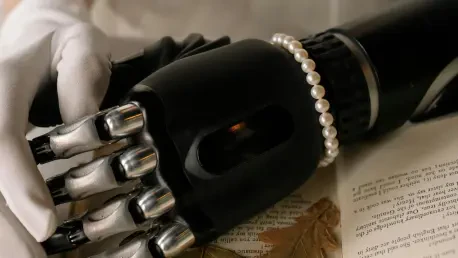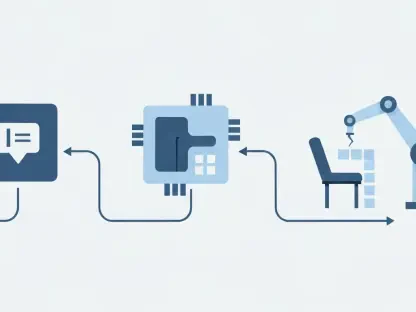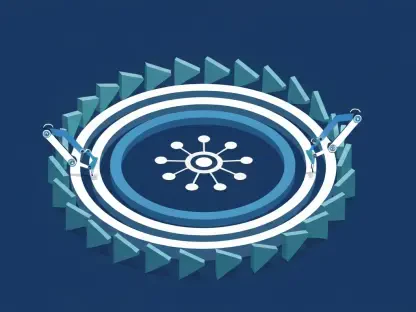The F-TAC Hand represents a monumental leap in the realm of robotics, offering unprecedented tactile capabilities and human-like dexterity crucial for real-world applications. This innovation stems from extensive research and development in robotic intelligence, now capable of dynamic interaction and adaptation to complex environments. Central to the F-TAC Hand’s functionality is its integration of tactile sensing across 70% of its surface, granting it the adaptive grasping abilities long desired in robotic systems. By effectively mimicking the sophisticated tactile feedback of human hands, this technology marks a significant advancement in overcoming one of robotics’ most persistent challenges.
Tackling Tactile Challenges in Robotics
The pursuit of replicating human hand capabilities in robotics has historically been impeded by a lack of adequate tactile feedback, crucial for navigating unpredictable and dynamic environments. Despite advancements in replicating hand kinematics and refining control algorithms, the complexity of tactile sensing posed a significant obstacle. With a spatial resolution of 0.1 mm, the F-TAC Hand offers a groundbreaking solution to this challenge, allowing robots to interpret and manipulate their surroundings with unparalleled precision. Such innovations are pivotal in enhancing robotic performance, enabling machines to go beyond rigid and limited actions and engage in complex, adaptive tasks.
Professor Kaspar Althoefer from Queen Mary University of London emphasizes the importance of this progress, noting that the F-TAC Hand’s extensive spatial resolution and coverage represent groundbreaking achievements in tactile sensing. The development of such sensors marks a paradigm shift by addressing fundamental limitations in previous robotic mechanisms. The enhanced tactile sensitivity facilitates superior understanding and interaction with diverse environments, ensuring robots can perform tasks that were once considered impossible. This step forward allows robots to potentially surpass human-like dexterity in certain applications, opening new horizons for what machines can achieve in various sectors.
Advanced Algorithms and Real-World Performance
In addition to its high-resolution tactile sensors, the F-TAC Hand employs advanced perception algorithms to refine its interaction with objects and environments. These algorithms are adept at determining critical parameters during grasping, ensuring effective handling in diverse and unpredictable scenarios. The combination of sophisticated processing and tactile feedback provides a comprehensive understanding of the task at hand, empowering the F-TAC Hand with human-like configuration capabilities. Its robust design ensures consistent performance amidst fluctuating conditions, positioning it as an exceptional tool in technologically demanding industries and applications.
Through rigorous testing spanning 600 real-world trials, the F-TAC Hand has demonstrated its efficacy, outperforming non-tactile systems in intricate manipulation tasks. The statistical significance of these results underscores the transformative impact rich tactile embodiment has on robotic intelligence. The system’s ability to maintain a full range of motion without compromising operational effectiveness illustrates its versatility. The insights gleaned from these trials suggest a promising future for tactile-focused robotic systems, which now hold the potential to revolutionize the way robots interact with human environments, seamlessly integrating into an array of industries and applications.
Expanding Robotic Applications
The advancements offered by the F-TAC Hand carry profound implications for robotics across multiple sectors. The enhanced tactile sensitivity and adaptive manipulation capabilities promise to revolutionize the interaction between robotic and human environments, paving the way for humanoid robots that actively support everyday tasks. From manufacturing to assistive technologies, and human-robot interactions, industries can benefit from machines that adapt to changeable settings. This adaptability ensures that robots can handle tasks previously limited to humans, promoting efficiency and fostering innovative solutions in numerous fields.
While the F-TAC Hand’s remarkable features focus primarily on technical applications, its implications extend beyond this domain. Robots equipped with advanced tactile abilities can improve the manipulation of delicate objects and excel in in-hand manipulation tasks. The integration of these capabilities allows robots to navigate complex environments with human-like proficiency. Humanoid robots become feasible partners in enhancing daily activities, offering support that goes beyond traditional robotic functionalities. This dual capability to aid and innovate presents a unique opportunity for the robotics field, bridging the gap between human and machine interaction, enhancing productivity and quality of life across various domains.
Pioneering Research and Future Prospects
The foundational work for the F-TAC Hand innovation originates from pioneering research conducted at Queen Mary University of London. Professor Althoefer and his former PhD student Wanlin Li spearheaded the initial development of camera-based tactile sensors, setting the stage for the high-resolution capabilities seen in modern applications. Their work was instrumental in designing sensors that exhibited exceptional spatial resolution and accuracy in measuring tactile information. This research served as a vital precursor to the sophisticated sensing technology integrated into the F-TAC Hand, highlighting the importance of concerted research efforts and innovation in advancing robotic capabilities.
As the F-TAC Hand continues to evolve, the potential for new applications and improvements remains boundless. Future developments might enhance its integration with other robotic systems, offering broader applications across industries. The continued expansion of its capabilities ensures that robotics will play an increasingly vital role in complementing human efforts, leading to smarter and more efficient solutions. This ongoing journey exemplifies the perpetual quest for innovation, with each advance in tactile sensing and algorithmic sophistication contributing to a future where robotic dexterity rivals and, potentially, surpasses human capabilities.
Charting New Frontiers in Robotics
The F-TAC Hand signifies a groundbreaking advancement in robotics, offering exceptional tactile abilities and human-like dexterity essential for practical and real-world uses. This technological feat is the result of extensive research and development in robotic intelligence, which now allows sophisticated interaction and adaptability within complex environments. What sets the F-TAC Hand apart is its tactile sensing capability, covering an impressive 70% of its surface area. This design provides it with adaptive grasping abilities that robotic systems have long aspired to achieve. By closely replicating the intricate tactile feedback found in human hands, the F-TAC Hand surmounts one of robotics’ most enduring obstacles. This technology doesn’t just mimic the human touch; it enhances the potential of robotic hands to operate in a variety of settings, from industrial applications to intricate tasks requiring subtlety and precision. It embodies a leap forward in making robots more effective partners in multiple sectors.









